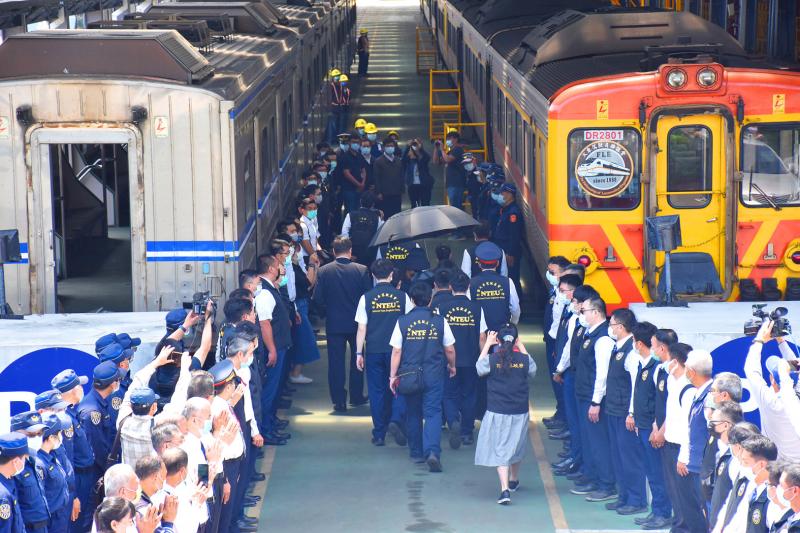The crane truck that caused last week’s fatal train accident had slid onto the tracks about one-and-a-half minutes before it was struck, the Taiwan Transportation Safety Board said yesterday.
The board had launched an investigation into the derailment, which killed 50 people and injured 211 people, making it the nation’s most devastating railway accident in decades.
Carrying 494 passengers and four Taiwan Railways Administration personnel, the southbound express train to Taitung hit the truck as it was about to enter the Cingshuei Tunnel (清水隧道) in Hualien’s Sioulin Township (秀林).

Photo: CNA
The train derailed following the collision, with the left side of the eighth carriage completely destroyed. The seventh carriage was severely deformed and detached from the sixth carriage, the board said.
The fourth, fifth and sixth carriages were twisted as well, it said.
Board investigators tried to reconstruct the accident from data retrieved from the train’s dashcam, an onboard automatic train protection system, train control management system, a vehicle data recorder (VDR) on the crane truck, and footage from surveillance cameras along a nearby highway and other data, board chairman Young Hong-tsu (楊宏智) said.
The crane truck entered the construction site at 8:49am on Friday, carrying a load of used tires, an investigation report said.
VDR data showed that there were other vehicles operating on site, including excavators and motorcycles, the board’s Rail Occurrence Investigation Division convener Li Gang (李綱) said.
The Taiwan Railways Administration said that it had informed contractors that they had to stop all construction work during the Tomb Sweeping Day long weekend.
The board also traced the movement of the crane truck from the VDR data, which showed that it slid down from the top of a slope and was stuck in the bushes when it hit a curve.
The VDR on the truck stopped recording after the truck’s engine was turned off, Li said.
“Based on footage from surveillance cameras and our on-site observation, we infer that the truck fell downhill through a treeless patch on the side of the slope after the engine was turned off and fell on the railroad, with the front of the truck facing the Heren Tunnel (和仁隧道), from which the Taroko Express emerged. A head-on collision ensued about one-and-a-half minutes after the truck flipped over onto the tracks,” Young said.
Asked if the driver left the truck after the engine was turned off, Young said that such information would be disclosed at the discretion of prosecutors.
Dashcam footage from the train showed that the driver could see the truck when the train emerged from the Heren Tunnel.
The train was traveling at 125kph, which means it would have needed 500m to 600m to come to a full stop.
The truck was about 240m from the Heren Tunnel, Young said.
Data from the train control management system showed the train driver and his assistant trying to stop the train by applying the brakes, but they only managed to slow it to 121kph.
The board found that the truck’s brake system was modified as well, Li said.
The board has disclosed about 70 to 80 percent of the evidence gathered on site during the holiday, Young said, adding that it would publish a complete report within four months.

The CIA has a message for Chinese government officials worried about their place in Chinese President Xi Jinping’s (習近平) government: Come work with us. The agency released two Mandarin-language videos on social media on Thursday inviting disgruntled officials to contact the CIA. The recruitment videos posted on YouTube and X racked up more than 5 million views combined in their first day. The outreach comes as CIA Director John Ratcliffe has vowed to boost the agency’s use of intelligence from human sources and its focus on China, which has recently targeted US officials with its own espionage operations. The videos are “aimed at

STEADFAST FRIEND: The bills encourage increased Taiwan-US engagement and address China’s distortion of UN Resolution 2758 to isolate Taiwan internationally The Presidential Office yesterday thanked the US House of Representatives for unanimously passing two Taiwan-related bills highlighting its solid support for Taiwan’s democracy and global participation, and for deepening bilateral relations. One of the bills, the Taiwan Assurance Implementation Act, requires the US Department of State to periodically review its guidelines for engagement with Taiwan, and report to the US Congress on the guidelines and plans to lift self-imposed limitations on US-Taiwan engagement. The other bill is the Taiwan International Solidarity Act, which clarifies that UN Resolution 2758 does not address the issue of the representation of Taiwan or its people in

US Indo-Pacific Commander Admiral Samuel Paparo on Friday expressed concern over the rate at which China is diversifying its military exercises, the Financial Times (FT) reported on Saturday. “The rates of change on the depth and breadth of their exercises is the one non-linear effect that I’ve seen in the last year that wakes me up at night or keeps me up at night,” Paparo was quoted by FT as saying while attending the annual Sedona Forum at the McCain Institute in Arizona. Paparo also expressed concern over the speed with which China was expanding its military. While the US

SHIFT: Taiwan’s better-than-expected first-quarter GDP and signs of weakness in the US have driven global capital back to emerging markets, the central bank head said The central bank yesterday blamed market speculation for the steep rise in the local currency, and urged exporters and financial institutions to stay calm and stop panic sell-offs to avoid hurting their own profitability. The nation’s top monetary policymaker said that it would step in, if necessary, to maintain order and stability in the foreign exchange market. The remarks came as the NT dollar yesterday closed up NT$0.919 to NT$30.145 against the US dollar in Taipei trading, after rising as high as NT$29.59 in intraday trading. The local currency has surged 5.85 percent against the greenback over the past two sessions, central